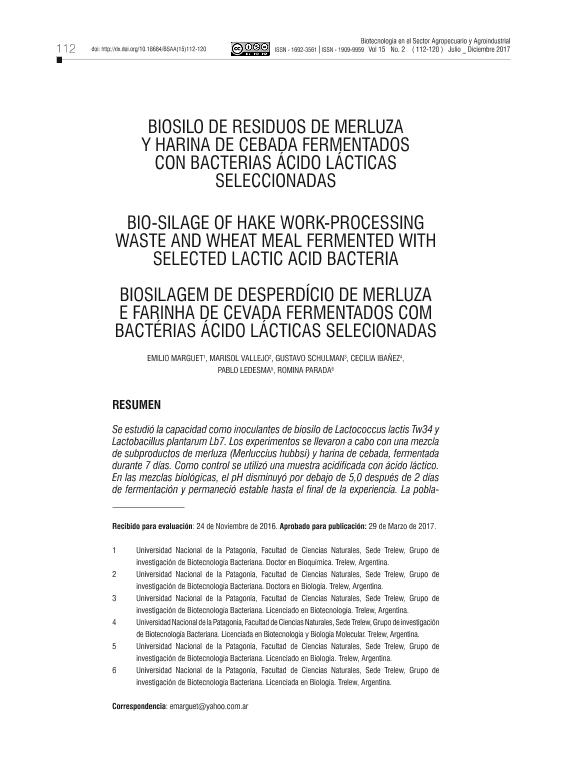Artículo
Suitability of Lactococcus lactis Tw34 and Lactobacillus plantarum Lb7 asbio-silage inoculants was studied. Experiments were carried out with a mixtureof hake (Merluccius hubbsi) by-products and barley meal fermentedduring 7 days. A sample acidified with lactic acid was used as control. Inbiological mixtures, the pH dropped below 5,0 after 2 days of fermentationand remained stable until the end of the experience. Maximum populations(> 109 CFU/g) were reached after 5 days of incubation at 18°C. Water solublepeptides concentration increased during the 7 days of incubation andno significant differences (p < 0,05) were found between the control andboth bio-silage. Trichloroacetic acid soluble peptides concentrations of biosilageswere higher than the control (p > 0,05). After 7 days, phosphorousconcentrations reached 2.26 and 2,42 g/100 g in bio-silages fermented withLc. lactis Tw34 and Lb. plantarum Lb7, respectively, while control values remainsalmost stable (1,61 g/100 g). At the end of the experience, inhibitoryactivity of trypsin was abolished in both bio-silage while in control sampleantinutritional factors remained active. The results indicated the feasibility ofthe use of the selected mixture as substrate for bio-silage production andthe effectiveness Lc. lactis Tw34 and Lb. plantarum Lb7 as inoculants. Suitability of Lactococcus lactis Tw34 and Lactobacillus plantarum Lb7 as bio-silage inoculants was studied. Experiments were carried out with a mixture of hake (Merluccius hubbsi) by-products and barley meal fermented during 7 days. A sample acidified with lactic acid was used as control. In biological mixtures, the pH dropped below 5,0 after 2 days of fermentation and remained stable until the end of the experience. Maximum populations (> 109 CFU/g) were reached after 5 days of incubation at 18°C. Water soluble peptides concentration increased during the 7 days of incubation and no significant differences (p < 0,05) were found between the control and both bio-silage. Trichloroacetic acid soluble peptides concentrations of biosilages were higher than the control (p > 0,05). After 7 days, phosphorous concentrations reached 2.26 and 2,42 g/100 g in bio-silages fermented with Lc. lactis Tw34 and Lb. plantarum Lb7, respectively, while control values remains almost stable (1,61 g/100 g). At the end of the experience, inhibitory activity of trypsin was abolished in both bio-silage while in control sample antinutritional factors remained active. The results indicated the feasibility of the use of the selected mixture as substrate for bio-silage production and the effectiveness Lc. lactis Tw34 and Lb. plantarum Lb7 as inoculants. Foi estudada a capacidade de inoculantes em biosilagem de Lactococcus lactis Tw34 y Lactobacillus plantarum Lb7. Os experimentos foram realizados com uma mistura de produtos de merluza (Merluccius hubbsi) e farinha de cevada, fermentada durante 7 dias. Como controle se utilizou uma amostra acidificada com ácido láctico. Nas misturas biológicas, o pH ficou abaixo 5,0 depois de 2 dias de fermentação e permaneceu estável até o final do experimento. A contagem máxima de viáveis (>109 UFC/g) foi alcançada depois de 5 dias de incubação a 18°C. A concentração de peptídeos solúveis em água aumentou durante os 7 dias de incubação e não houve diferença significativa (p < 0,05) entre o controle e a silagem. As concentrações de peptídeos solúveis em ácido tricloroacético da silagem foram superiores ao controle (p >0,05). Depois de 7 dias, as concentrações de fósforo alcançadas foram de 2,26 e 2,42 g/100 g nas silagens fermentadas com Lc. lactis Tw34 e Lb. plantarum Lb7 respectivamente, en quanto que no controle os valores permaneceram quase estáveis (1,61 g/100 g). No final do experimento, a atividade inibitória de tripsina foi suprimida em ambas silagens enquanto que no controle os fatores antinutricionais continuavam ativos. Os resultados indicam a possibilidade do uso de uma mistura selecionada como substrato para a produção de silagem e a capacidade de Lc. lactis Tw34 e Lb. plantarum Lb7 como inoculantes.
Biosilo de residuos de merluza y harina de cebada fermentados con bacterias ácido láctica
Título:
Bio-silage of hake work-processing waste and wheat meal fermented with selected lactic acid bacteria;
Biosilagem de desperdício de merluza e farinha de cevada fermentados com bactérias ácido lácticas selecionadas
Biosilagem de desperdício de merluza e farinha de cevada fermentados com bactérias ácido lácticas selecionadas
Marguet, Emilio Rogelio; Vallejo, Marisol ; Schulman, Gustavo
; Schulman, Gustavo ; Ibañez, Cecilia Mariel; Ledesma, Pablo Jeronimo
; Ibañez, Cecilia Mariel; Ledesma, Pablo Jeronimo ; Parada, Romina Belén
; Parada, Romina Belén
 ; Schulman, Gustavo
; Schulman, Gustavo ; Ibañez, Cecilia Mariel; Ledesma, Pablo Jeronimo
; Ibañez, Cecilia Mariel; Ledesma, Pablo Jeronimo ; Parada, Romina Belén
; Parada, Romina Belén
Fecha de publicación:
07/2017
Editorial:
Universidad de Cauca. Facultad de Ciencias Agrarias
Revista:
Biotecnoloía en el Sector Agropecuario y Agroindustrial
ISSN:
1692-3561
e-ISSN:
1909-9959
Idioma:
Español
Tipo de recurso:
Artículo publicado
Clasificación temática:
Resumen
Palabras clave:
Biosilo
,
Merluza
,
Cebada
,
Fermentación
,
Merluza
Archivos asociados
Licencia
Identificadores
Colecciones
Articulos(SEDE CENTRAL)
Articulos de SEDE CENTRAL
Articulos de SEDE CENTRAL
Citación
Marguet, Emilio Rogelio; Vallejo, Marisol; Schulman, Gustavo; Ibañez, Cecilia Mariel; Ledesma, Pablo Jeronimo; et al.; Biosilo de residuos de merluza y harina de cebada fermentados con bacterias ácido láctica; Universidad de Cauca. Facultad de Ciencias Agrarias; Biotecnoloía en el Sector Agropecuario y Agroindustrial; 15; 2; 7-2017; 112-120
Compartir
Altmétricas



